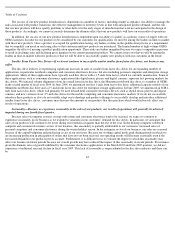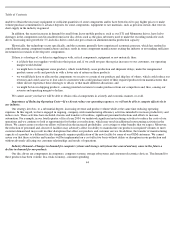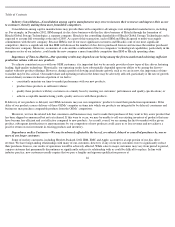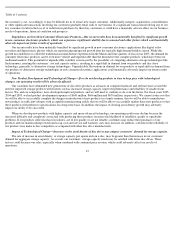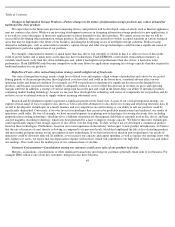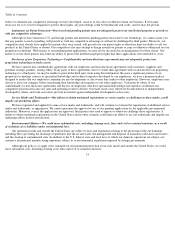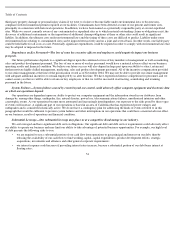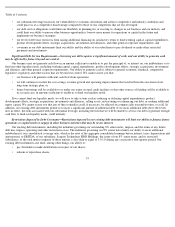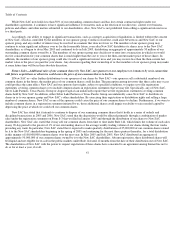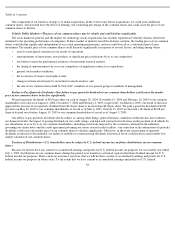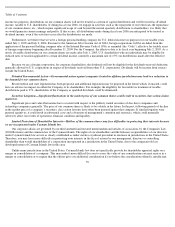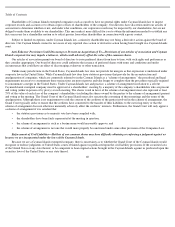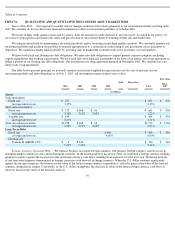Seagate 2004 Annual Report Download - page 54
Download and view the complete annual report
Please find page 54 of the 2004 Seagate annual report below. You can navigate through the pages in the report by either clicking on the pages listed below, or by using the keyword search tool below to find specific information within the annual report.
Table of Contents
that integration of acquired companies would lead to the loss of key employees from those companies or the loss of customers of those
companies. In addition, the integration of any acquired companies would require substantial attention from our senior management, which may
limit the amount of time available to be devoted to our day-to-day operations or to the execution of our strategy. Furthermore, the expansion of
our business involves the risk that we might not manage our growth effectively, that we would incur additional debt to finance these
acquisitions or investments and that we would incur substantial charges relating to the write-off of in-process research and development,
similar to that which we incurred in connection with several of our prior acquisitions. Each of these items could have a material adverse effect
on our financial position and results of operations.
Potential Loss of Licensed Technology—The closing of the November 2000 transactions may have triggered change of control or
anti-assignment provisions in some of our license agreements, which could result in a loss of our right to use licensed technology.
We have a number of cross-licenses with third parties that enable us to manufacture our products free from any infringement claims that
might otherwise be made by these third parties against us. A number of these licenses contain change of control or anti-assignment provisions.
We have taken steps to transfer these licenses in connection with the closing of the November 2000 transactions; however, we cannot assure
you that these transfers will not be challenged. For example, Papst Licensing GmbH, IBM and Hitachi initially took the position that their
license agreements did not transfer to our new business entities. Subsequently, we entered into new license agreements with IBM and Hitachi
in December 2001. In September 2002, we settled a broader dispute with Papst that also resolved the claim by Papst that its license agreement
was not properly transferred.
We received a letter dated November 20, 2002 from Read-Rite Corporation asserting that we do not currently have a license to its
patented technology and that our disc drive products infringe at least two of its patents. We have since received additional letters from Read-
Rite Corporation making the same claims. Seagate Technology, Inc. entered into a Patent Cross License Agreement dated December 31, 1994,
which covered the two patents referenced in the November 20, 2002 letter, as well as other intellectual property of Read-Rite Corporation.
Prior to the November 20, 2002 letter, Read-Rite Corporation had not responded to our efforts to confirm that under the Patent Cross License
Agreement we were entitled to a new license agreement in our own name and on materially the same terms as the 1994 agreement. In order to
clarify the parties’ rights under the Patent Cross License Agreement, we filed a declaratory judgment action on May 7, 2003 in the Superior
Court of California, County of Santa Clara, seeking a declaration that we are entitled to a cross-license, effective as of November 22, 2000,
under terms substantially identical to those contained in the Patent Cross License Agreement. On June 11, 2003 Read-Rite Corporation
answered the complaint putting forward a general denial and asserting various affirmative defenses. On June 17, 2003, Read-Rite Corporation
filed a voluntary petition for bankruptcy under Chapter 7 of the U.S. Bankruptcy Code. Upon notice, our declaratory judgment action has been
stayed. On July 23, 2003, the U.S. Bankruptcy Court approved Western Digital Corporation’s bid to acquire the assets of Read-Rite
Corporation, including the intellectual property that was the subject of Read-Rite’s dispute with us, in a transaction that closed on July 31,
2003. In the Bankruptcy Court, we objected to the Chapter 7 Trustee’s assumption and assignment to Western Digital of the Patent Cross-
License Agreement, and the Trustee ultimately rejected the Agreement. On November 14, 2003, the Bankruptcy Trustee made a motion,
continued from time to time, to assume or reject certain Read-Rite executory contracts, rejecting the Patent Cross-License Agreement. On
November 12, 2004, we filed our election to retain the benefits of the Patent Cross
-License Agreement to the extent permitted by Section 365
(n) of the U.S. Bankruptcy Code. The Chapter 7 Trustee and Western Digital opposed our election to retain the benefits of the license. We have
since reached agreement with the Bankruptcy Trustee, subject to Bankruptcy Court approval, to allow us to retain the benefits of the Patent
Cross-License in exchange for us withdrawing our proof of claim against the bankruptcy estate. Western Digital objected to the settlement. On
July 7, 2005, the Bankruptcy Trustee filed a motion to approve settlement of all bankruptcy disputes with Western Digital and indicated that he
no longer supports the agreement we reached with him. Pursuant to this motion, the Bankruptcy Trustee seeks approval to appoint Western
Digital as the estate’s attorney in fact involving our election to retain the benefits of the Patent Cross-License
51



